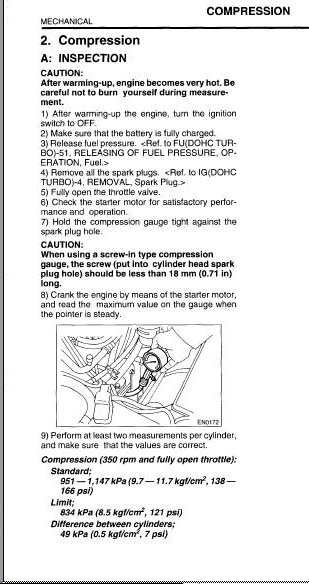|
What does a compression
test tell me?
It will tell you if your
engine has good compression. An engine is essentially a self-powered
air pump, so it needs good compression to run efficiently, cleanly and
to start easily.
As a rule, Subaru
engines should have 142 to 170 lbs. of cranking compression with no
more than 10% difference between any of the cylinders.
Low compression in one
cylinder usually indicates a bad exhaust valve. Low compression in two
adjacent cylinders typically means you have a bad head gasket. Low
compression in all cylinders would tell you the rings and cylinders are
worn and the engine needs to be overhauled.
CHECKING COMPRESSION
Compression can be
checked two ways: manually with a compression gauge or electronically
with an engine analyzer. The manual gauge method is the only one
available to most do-it-yourselfers.
To check compression,
all the spark plugs are removed. The ignition coil is then disabled or
the high-tension lead is grounded. The throttle is also held open. The
engine is then cranked for a few seconds using a remote starter switch
or a helper while a compression gauge is held in a spark plug hole. The
maximum compression reading is noted, and then the process is repeated
for each of the remaining cylinders. The individual cylinder readings
are then compared to see if the results are within specs (always refer
to a manual for the exact compression specs for your engine because
they do vary from the ballpark figures we quoted earlier).
If compression is low in
one or more cylinders, you can isolate the problem to the valves or
rings by squirting a little 30 weight motor oil into the cylinder
through the spark plug hole and repeating the compression test. The oil
temporarily seals the rings. If the readings are higher the second time
around, it means the rings and/or cylinder is worn. No change in the
compression readings tells you the cylinder has a bad valve.
With electronic testing,
a computer analyzer "estimates" compression in each of the engine's
cylinders by measuring slight variations in engine cranking speed. The
results correlate well with actual gauge readings and can be completed
in a matter of minutes without having to remove any spark plugs. What's
more, the analyzer prints out the results of the compression test
making it easy to see and compare the actual numbers.
LEAK TEST
What is a "leak down"
test?
Answer: A leak down or
"cylinder leakage" test is similar to a compression test in that it
tells you how well your engine's cylinders are sealing. But instead of
measuring pressure, it measures pressure loss.
A leak down test
requires the removal of all the spark plugs. The crankshaft is then
turned so that each piston is at top dead center (both valves closed)
when each cylinder is tested. Most people start with cylinder number
one and follow the engine's firing order.
A threaded coupling
attached to a leakage gauge is screwed into a spark plug hole.
Compressed air (80 to 90 psi) is then fed into the cylinder.
An engine in great
condition should generally show only 5 to 10% leakage. An engine that's
still in pretty good condition may show up to 20% leakage. But more
than 30% leakage indicates trouble.
The neat thing about a
leakage test (as opposed to a compression test) is that it's faster and
easier to figure out where the pressure is going. If you hear air
coming out of the tailpipe, it indicates a leaky exhaust valve. Air
coming out of the throttle body or carburetor would point to a leaky
intake valve. Air coming out of the breather vent or PCV valve fitting
would tell you the rings and/or cylinders are worn.
A leakage test can also
be used in conjunction with a compression test to diagnose other kinds
of problems.
A cylinder that has poor
compression, but minimal leakage, usually has a valve train problem
such as a worn cam lobe, broken valve spring, collapsed lifter, bent
push rod, etc.
If all the cylinders
have low compression, but show minimal leakage, the most likely cause
is incorrect valve timing. The timing belt or chain may be off a notch
or two.
If compression is good
and leakage is minimal, but a cylinder is misfiring or shows up weak in
a power balance test, it indicates a fuel delivery (bad injector) or
ignition problem (fouled spark plug or bad plug wire)
Here is the page for
compression test in the WRX shop manual

|
